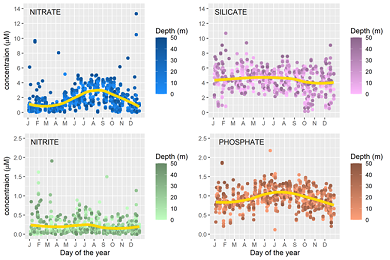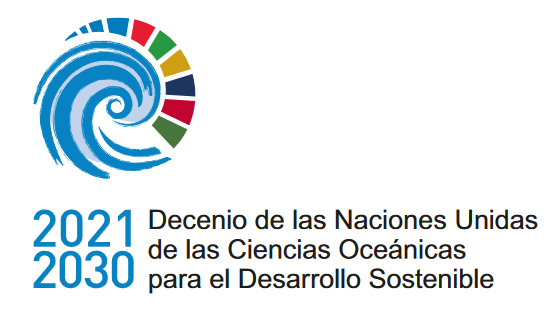Variabilidad estacional de la estructura de la comunidad fitoplanctónica en una estación costera de la plataforma continental argentina basada en un enfoque quimiotaxonómico
DOI:
https://doi.org/10.47193/mafis.3812025010105Palabras clave:
CHEMTAX, pigmentos fitoplanctónicos, nutrientes, dinoflagelados, floraciones algales nocivas, Atlántico SudoccidentalResumen
Se caracterizó la composición, abundancia y estructura de tamaño de la comunidad fitoplanctónica en una estación costera (38° 28' S-57° 41' W, EPEA, Argentina) de serie de tiempo aplicando el enfoque quimiotaxonómico. Se identificó la variabilidad estacional de la diversidad de pigmentos determinada por cromatografía líquida de alta resolución (HPLC, n = 171), la concentración de nutrientes (n = 934) y la temperatura, salinidad y grado de estratificación de la columna de agua (n = 190 perfiles CTD). Se utilizó el programa CHEMTAX para estimar la abundancia de fitoplancton en términos de contribución a la concentración de clorofila a de los diferentes tipos pigmentarios de fitoplancton (PPTs). Se compararon dos índices pigmentarios diferentes para estimar las fracciones de tamaño de la comunidad fitoplanctónica a lo largo del año, obteniéndose resultados contrastantes. La columna de agua estuvo mayoritariamente mezclada, con temperaturas mínimas entre julio y septiembre, y máximas entre enero y marzo (rango: 8-23 °C). El nitrato fue el nutriente limitante, con concentraciones mínimas al final del verano. Su rango varió entre 0.010-13.330 μM, mientras que el silicato varió entre 0.016-10.670 μM sin grandes variaciones estacionales, y el fosfato entre 0.120-2.180 μM. La fucoxantina, clorofila c2, 19’-hexanoil-oxi-fucoxantina, diadinoxantina, clorofila b, clorofila c3, peridinina y aloxantina fueron los pigmentos fitoplanctónicos más frecuentes. Los PPT DINO-1 (dinoflagelados con peridinina), y los tipos de haptofitas HAPTO-6, HAPTO-7 y HAPTO-P mostraron un ciclo estacional con picos de abundancia en otoño y primavera, mientras que la abundancia de diatomeas DIATO-1 fue alta durante todo el año, y las DIATO-2 principalmente durante el invierno. Se describió un perfil de pigmentos de un grupo de primnesiófitas que poseen MVChl_c3. Se evidenció que en este sitio los PPTs que tienen especies potencialmente tóxicas florecen bajo diferentes condiciones hidrológicas. Es probable que DINO-1 florezca en abril (otoño) con temperaturas cercanas a 18 °C y condiciones de estratificación débil, mientras que la floración de octubre (primavera) ocurre con temperaturas más bajas de 10-12 °C. DINO-4 se observó durante enero y febrero (verano), cuando la temperatura fue > 18 °C, la salinidad < 33,7 y la columna de agua mostró una estratificación máxima. En cambio, las máximas abundancias de DIATO-2 se dieron entre agosto y septiembre (invierno), en condiciones de mezcla completa, alta concentración de nitratos y baja temperatura de 10 °C. Este trabajo constituye la primera descripción de la variabilidad de la abundancia de los principales PPTs en una estación de series de tiempo costera en la plataforma del Atlántico Sudoccidental a lo largo del ciclo anual, demostrando el poder de la quimiotaxonomía y CHEMTAX para realizar análisis descriptivos de un gran número de muestras.
Descargas
Referencias
Akselman R, Carreto JI, Montoya NG. 1998. Gymnodinium catenatum and autumn toxicity in northern shelf waters of Argentina. In: Reguera B, Blanco J, Fernández ML, Wyatt T, editors. Harmful Algae. Santiago de Compostela: Xunta de Galicia and Intergovernmental Oceanographic Commission of UNESCO. p. 122-123.
Akselman R, Negri RM. 2012. Blooms of Azadinium cf. spinosum Elbrächter et Tillmann (Dinophyceae) in northern shelf waters of Argentina, Southwestern Atlantic. Harmful Algae. 19: 30-38.
Akselman R, Negri RM, Cozzolino E. 2014. Azadinium (Amphidomataceae, Dinophyceae) in the Southwest Atlantic: in situ and satellite observations. Rev Biol Mar Oceanog. 49: 511-526.
Armbrecht LH, Wright SW, Petocz P, Armand LK. 2015. A new approach to testing the agreement of two phytoplankton quantification techniques: microscopy and CHEMTAX. Limnol Oceanogr Methods. 13 (8): 425-437.
Armstrong FAJ, Stearns CR, Strickland JDH. 1967. The measurement of upwelling and subsequent biological process by means of the Technicon Autoanalyzer® and associated equipment. Deep-Sea Res. 14 (3): 381-389.
BaRDO. 2023. Base Regional de Datos Oceanográficos (BaRDO). Gabinete de Oceanografía Física. Mar del Plata: Instituto Nacional de Investigación y Desarrollo Pesquero (INIDEP). https://www.argentina.gob.ar/inidep.
Bouman H, Platt T, Sathyendranath S, Stuart V. 2005. Dependence of light-saturated photosynthesis on temperature and community structure. Deep-Sea Res I Oceanogr Res Pap. 52 (7): 1284-1299.
Brewin RJW, Sathyendranath S, Hirata T, Lavender SJ, Barciela RM, Hardman-Mountford NJ. 2010. A three-component model of phytoplankton size class for the Atlantic Ocean. Ecol Model. 221 (11): 1472-1483.
Cadaillón AM, Mattera B, Albizzi A, Montoya N, Maldonado S, Raya Rey A, Riccialdelli L, Almandoz GO, Schloss IR. 2024. Multispecies mass mortality in the Beagle Channel associated with paralytic shellfish toxins. Harmful Algae. 132: 102581.
Cai Y, Cao Y, Tang C. 2019. Evidence for the primary role of phytoplankton on nitrogen cycle in a subtropical reservoir: reflected by the stable isotope ratios of particulate nitrogen and total dissolved nitrogen. Front Microbiol. 10: 2202.
Carreto J, Montoya N, Akselman R, Negri R, Carignan M, Cucchi Colleoni A. 2004. Differences in the PSP toxin profiles of Mytilus edulis during spring and autumn blooms of Alexandrium tamarense off Mar del Plata coast, Argentina. In: Steidinger K, Landsberg J, Tomas C, Vargo G, editors. Harmful Algae 2002. St. Petersburg: Florida Fish and Wildlife Conservation Commission, Florida Institute of Oceanography, and Intergovernmental Oceanographic Commission of UNESCO. p. 100-102.
Carreto J, Ramirez F, Roa B, Verona C. 1973. Plancton y condiciones ecológicas de la plataforma bonaerense, frente a Mar del Plata. II. Campaña “Transección II”. FAO Documento Técnico Preliminar 30.
Carreto JI, Carignan MO, Montoya NG, Cozzolino E, Akselman R. 2018. Mycosporine-like amino acids and xanthophyll-cycle pigments favour a massive spring bloom development of the dinoflagellate Prorocentrum minimum in Grande Bay (Argentina), an ozone hole affected area. J Mar Syst. 178: 15-28.
Carreto JI, Elbusto C, Sancho H, Carignan MO, Cucchi Colleoni AD, De Marco SG, Fernández A. 1993. An exploratory analysis of the Mar del Plata shellfish toxicity area (1980 1990). In: Smayda TJ, Shimizu Y, editors. Toxic phytoplankton blooms in the sea; Newport, Rhode Island, USA. Elsevier. p. 952.
Carreto JI, Montoya NG, Akselman R, Carignan MO, Silva RI, Colleoni DAC. 2008. Algal pigment patterns and phytoplankton assemblages in different water masses of the Río de la Plata maritime front. Cont Shelf Res. 28: 1589-1606.
Carreto JI, Montoya NG, Benavides HR, Guerrero R, Carignan MO. 2003. Characterization of spring phytoplankton communities in the Río de La Plata maritime front using pigment signatures and cell microscopy. Mar Biol. 143: 1013-1027.
Carreto JI, Montoya NG, Carignan MO, Akselman R, Acha EM, Derisio C. 2016. Environmental and biological factors controlling the spring phytoplankton bloom at the Patagonian shelf-break front - Degraded fucoxanthin pigments and the importance of microzooplankton grazing. Prog Oceanogr. 146: 1-21.
Chase AP, Kramer SJ, Haëntjens N, Boss ES, Karp-Boss L, Edmondson M, Graff JR. 2020. Evaluation of diagnostic pigments to estimate phytoplankton size classes. Limnol Oceanogr Methods. 18 (10): 570-584.
Devred E, Sathyendranath S, Stuart V, Platt T. 2011. A three component classification of phytoplankton absorption spectra: application to ocean-color data. Remote Sens Environ. 115 (9): 2255-2266.
Escalera L, Reguera B, Pazos Y, Moroño A, Cabanas JM. 2006. Are different species of Dinophysis selected by climatological conditions? Afr J Mar Sci. 28 (2): 283-288.
Fabro E, Almandoz GO, Ferrario M, John U, Tillmann U, Toebe K, Krock B, Cembella A. 2017. Morphological, molecular, and toxin analysis of field populations of Alexandrium genus from the Argentine Sea. J Phycol. 53 (6): 1206-1222.
Garrido JL, Zapata M. 1997. Reversed-phase high-performance liquid chromatographic separation of mono- and divinyl chlorophyll forms using pyridine-containing mobile phases and a polymeric octadecylsilica column. Chromatographia. 44 (1): 43-49.
Goela PC, Icely J, Cristina S, Danchenko S, Angel Delvalls T, Newton A. 2015. Using bio-optical parameters as a tool for detecting changes in the phytoplankton community (SW Portugal). Estuar Coast Shelf Sci. 167: 125-137.
Grasshoff K, Manfred E, Klaus K, editors. 1983. Methods of seawater analysis. 2nd ed. Weinheim: Verlag Chemie.
Guerrero R, Piola A. 1997. Masas de agua en la Plataforma Continental Argentina. In: Boschi EE, editor. El Mar Argentino y sus recursos pesqueros. Tomo 1. Antecedentes históricos de las exploraciones en el mar y las características ambientales. Mar del Plata: Instituto Nacional de Investigación y Desarrollo Pesquero (INIDEP). p. 107-118.
Hirata T, Aiken J, Hardman-Mountford, Smyth TJ, Barlow RG. 2008. An absorption model to determine phytoplankton size classes from satellite ocean colour. Remote Sens Environ. 112: 3153-3159.
Jeffrey SW, Mantoura RF, Wright SW. 1997. Phytoplankton pigments in oceanography: guidelines to modern methods. Paris: UNESCO. 661 p.
Jeffrey SW, Wright SW, Zapata M. 2011. Microalgal classes and their signature pigments. In: Roy S, Llewellyn CA, Egeland ES, Johnsen G, editors. Phytoplankton pigments: characterization, chemotaxonomy and applications in oceanography. Cambridge: Cambridge University Press. p. 3-77.
Krock B, Ferrario ME, Akselman R, Montoya NG. 2018. Occurrence of marine biotoxins and shellfish poisoning events and their causative organisms in Argentine marine waters. Oceanography. 31 (4): 132-144.
Lange KB. 1985. Spatial and seasonal variations of diatom assemblages off the Argentinean coast (South Western Atlantic). Oceanol Acta. 8 (3): 361-369.
Larios-Muñiz M, González-Silvera A, Castro R, Santamaría-Del-Ángel E, Collins CA, López-Calderón J. 2022. Variability of hydrographic factors, biomass and structure of the phytoplankton community at the entrance to the Gulf of California (spring 2013). Cont Shelf Res. 235: 104665.
Llewellyn CA, Egeland ES, Johnsen G, Roy S. 2011. Abbreviations and symbols. In: Roy S, Llewellyn CA, Egeland ES, Johnsen G, editors. Phytoplankton pigments: characterization, chemotaxonomy and applications in oceanography. Cambridge: Cambridge University Press. p. 25-28.
Lutz VA, Subramaniam A, Negri MR, Silva RI, Carreto JI. 2006. Annual variations in bio-optical properties at the “Estación Permanente de Estudios Ambientales (EPEA)” coastal station, Argentina. Cont Shelf Res. 26: 1093-1112.
Mackey MD, Mackey DJ, Higgins HW, Wright SW. 1996. Chemtax: a program for estimating class abundances from chemical markers: application to HPLC measurements of phytoplankton. Mar Ecol Prog Ser. 144 (1/3): 265-283.
Méndez SM, Carreto JI. 2018. Harmful algal blooms in the Río de la Plata region. In: Hoffmeyer MS, Sabatini ME, Brandini FP, Calliari DL, Santinelli NH, editors. Plankton ecology of the Southwestern Atlantic: from the subtropical to the subantarctic realm. Cham: Springer International Publishing. p. 477-493.
Méndez SM, Medina D. 2004. Twenty-three years of red tide monitoring at fixed stations along the coast of Uruguay. In: Steidinger KA, Landsberg JHC, Tomas R, Vargo GA, editors. Harmful Algae 2002. St. Petersburg: Florida Fish and Wildlife Conservation Commission, Florida Institute of Oceanography, and Intergovernmental Oceanographic Commission of UNESCO. p. 341-343.
Montoya NG. 2019. Paralyzing shellfish toxins in the Argentine Sea: impact, trophic transfer and perspective. Mar Fish Sci. 32 (1): 47-69.
Montoya NG, Benavídez H, Carignan MO. 2008. Determinación de ácido okadaico y primera detección de pectenotoxinas asociadas a la presencia de Dinophysis sp. en el litoral argentino. Inf Invest INIDEP Nº 1/2008. 15 p.
Montoya NG, Carignan MO, Carreto JI. 2018. Alexandrium tamarense/catenella blooms in the Southwestern Atlantic: paralytic shellfish toxin production and its trophic transference. In: Hoffmeyer MS, Sabatini ME, Brandini FP, Calliari DL, Santinelli NH, editors. Plankton ecology of the Southwestern Atlantic: from the subtropical to the subantarctic realm. Cham: Springer International Publishing. p. 453-476.
Montoya NG, Carignan MO, Mattera MB. 2020. Toxinas algales en el Mar Argentino: nuevos hallazgos, nuevos desafíos. Acta Toxicol Argent. 28 (3): 92-107.
Montoya NG, Mattera Coy MB, Carignan MO. 2015. Caracterización pigmentaria de cultivos de fitoplancton. Inf Invest INIDEP Nº 57/2015. 14 p.
Murphy J, Riley JP. 1962. A modified single solution method for the determination of phosphate in natural waters. Anal Chim Acta. 27: 31-36.
Negri R, Silva RI. 2011. Estructura de la comunidad del fitoplancton en la estación costera EPEA durante el período 2000-2010 (provincia de Buenos Aires, Argentina). Bol Soc Argent Bot. 46: 99-100.
Negri RM. 2005. INIDEP, Informe de la campaña (CC-10/2005). Marea roja-dinámica del plancton, EPEA VII/05. Mar del Plata: Biblioteca INIDEP. 4 p.
Negri RM. 2019. Series de tiempo ecológicas Costal I-EPEA I/2019. Inf Camp INIDEP Nº 16/2019. 2 p.
Nunes S, Perez Gl, Latasa M, Zamanillo M, Delgado M, Ortega-Retuerta E, Marrasé C, Simó R, Estrada M. 2019. Size fractionation, chemotaxonomic groups and bio-optical properties of phytoplankton along a transect from the Mediterranean Sea to the SW Atlantic Ocean. Sci Mar. 83 (2): 87-109.
Rodríguez F, Varela M, Zapata M. 2002. Phytoplankton assemblages in the Gerlache and Bransfield straits (Antarctic Peninsula) determined by light microscopy and CHEMTAX analysis of HPLC pigment data. Deep-Sea Res II Top Stud Oceanogr. 49 (4): 723-747.
Ruiz MG. 2018. Variabilidad de las propiedades bio-ópticas en la serie de tiempo Estación permanente de estudios Ambientales (EPEA) complementando mediciones in situ y satelitales [PhD thesis]. Mar del Plata: Facultad de Ciencias Exactas y Naturales, Universidad Nacional de Mar del Plata. 128 p.
Ruiz MG, Lutz VA, Segura V, Berghoff CF, Negri RM. 2020. The color of EPEA: variability in the in situ bio-optical properties in the period 2000-2017. Mar Fish Sci. 33 (2): 205-225.
Ruiz MG, Silva R, Martínez Goycochea A, Montoya NG. 2023. Relaciones pigmento:clorofila a determinadas por CHEMTAX a partir de muestras naturales de floraciones algales de la región norte de la plataforma continental argentina. Inf Invest INIDEP Nº 72/2023. 20 p.
Sar EA, Sunesen I, Goya AB, Lavigne AS, Tapia E, Garcia C, Lagos N. 2012. First report of diarrhetic shellfish toxins in mollusks from Buenos Aires Province (Argentina) associated to Dinophysis spp.: evidence of Okadaic acid, Dinophysistoxin-1 and Acyl-derivatives. Bol Soc Argent Bot. 47 (1/2): 5-14.
Schlüter L, Møhlenberg F, Havskum H, Larsen S. 2000. The use of phytoplankton pigments for identifying and quantifying phytoplankton groups in coastal areas: testing the influence of light and nutrients on pigment/chlorophyll a ratios. Mar Ecol Prog Ser. 192: 49-63.
Sieburth JM, Smetacek V, Lenz JR. 1978. Pelagic ecosystem structure: heterotrophic compartments of the plankton and their relationship to plankton size fractions 1. Limnol Oceanogr. 23 (6): 1256-1263.
Silva R, Negri R, Lutz V. 2009. Summer succession of ultraphytoplankton at the EPEA coastal station (Northern Argentina). J Plankton Res. 31 (4): 447-458.
Silva RI. 2011. Dinámica del ultrafitoplancton en el Mar Argentino [PhD thesis]. Mar del Plata: Facultad de Ciencias Exactas y Naturales, Universidad Nacional de Mar del Plata. 187 p.
Simpson JH, Crisp DJ, Hearn C, Swallow JC, Currie RI, Gill AE, Simpson JH. 1981. The shelf-sea fronts: implications of their existence and behaviour. Philos Trans R Soc Ser A. 302 (1472): 531-546.
Uitz J, Claustre H, Morel A, Hooker S. 2006. Vertical distribution of phytoplankton communities in open ocean: an assessment based on surface chlorophyll. J Geophys Res C Oceans. 111 (C8): C08005. DOI: https://doi.org/10.1029/2005JC003207
Vidussi F, Claustre H, Manca BB, Luchetta A, Marty J-C. 2001. Phytoplankton pigment distribution in relation to upper thermocline circulation in the eastern Mediterranean Sea during winter. J Geophys Res C Oceans. 106 (C9): 19939-19956.
Viñas MD, Negri RM, Cepeda GD, Hernández D, Silva R, Daponte MC, Capitanio FL. 2013. Seasonal succession of zooplankton in coastal waters of the Argentine Sea (Southwest Atlantic Ocean): prevalence of classical or microbial food webs. Mar Biol Res. 9 (4): 371-382.
Zapata M, Jeffrey SW, Wright SW, Rodríguez F, Garrido JL, Clementson L. 2004. Photosynthetic pigments in 37 species (65 strains) of Haptophyta: implications for oceanography and chemotaxonomy. Mar Ecol Prog Ser. 270: 83-102.
Zapata M, Rodríguez F, Garrido JL. 2000. Separation of chlorophylls and carotenoids from marine phytoplankton: a new HPLC method using a reversed phase C8 column and pyridine-containing mobile phases. Mar Ecol Prog Ser. 195: 29-45.

Descargas
Publicado
Número
Sección
Licencia
Derechos de autor 2025 M. Guillermina Ruiz, M. Belén Mattera Coy, Mario C. Carignan, Macarena Albornoz, Graciela N. Molinari, Nora G. Montoya

Esta obra está bajo una licencia internacional Creative Commons Atribución-NoComercial-CompartirIgual 4.0.
Los autores de los artículos publicados en Marine and Fishery Sciences conservan los derechos de autor de sus artículos, a excepción de las imágenes de terceros y otros materiales añadidos por Marine and Fishery Sciences, que están sujetos a los derechos de autor de sus respectivos propietarios. Por lo tanto, los autores son libres de difundir y volver a publicar sus artículos, sujeto a los requisitos de los propietarios de derechos de autor de terceros y sujeto a que la publicación original sea completamente citada. Los visitantes también pueden descargar y reenviar artículos sujetos a los requisitos de citas. La capacidad de copiar, descargar, reenviar o distribuir cualquier material siempre está sujeta a los avisos de derechos de autor que se muestran. Los avisos de copyright deben mostrarse de manera prominente y no pueden borrarse, eliminarse u ocultarse, total o parcialmente. El autoalmacenamiento en servidores y repositorios de preimpresión está permitido para todas las versiones.
Esta revista ofrece a los autores una política de acceso abierto. Los usuarios pueden leer, descargar, copiar, distribuir, imprimir, buscar o vincular los textos completos de los artículos, o usarlos para cualquier otro propósito legal dentro de la licencia Creative Commons 4.0 (BY-NC-SA), sin solicitar permiso previo del editor o del autor. Esto está de acuerdo con la definición BOAI de acceso abierto.






















